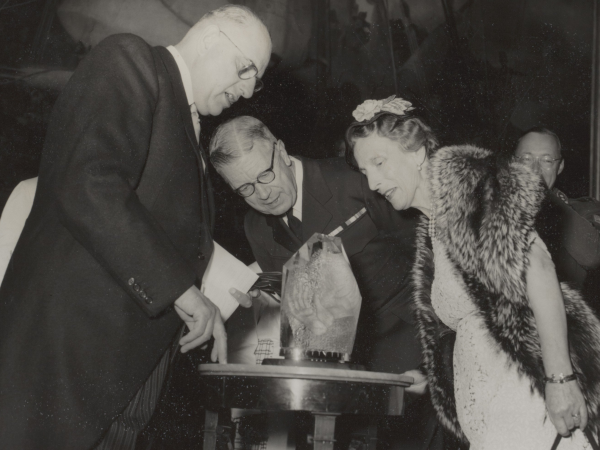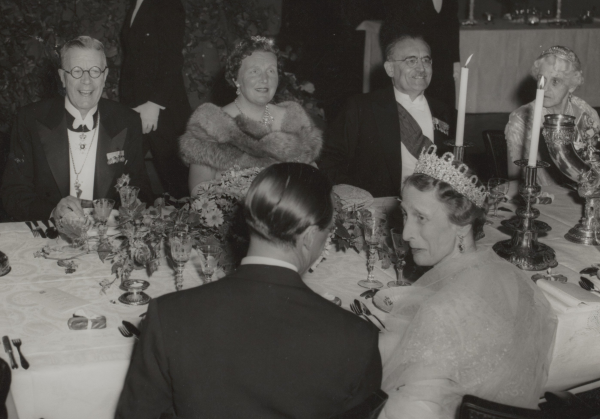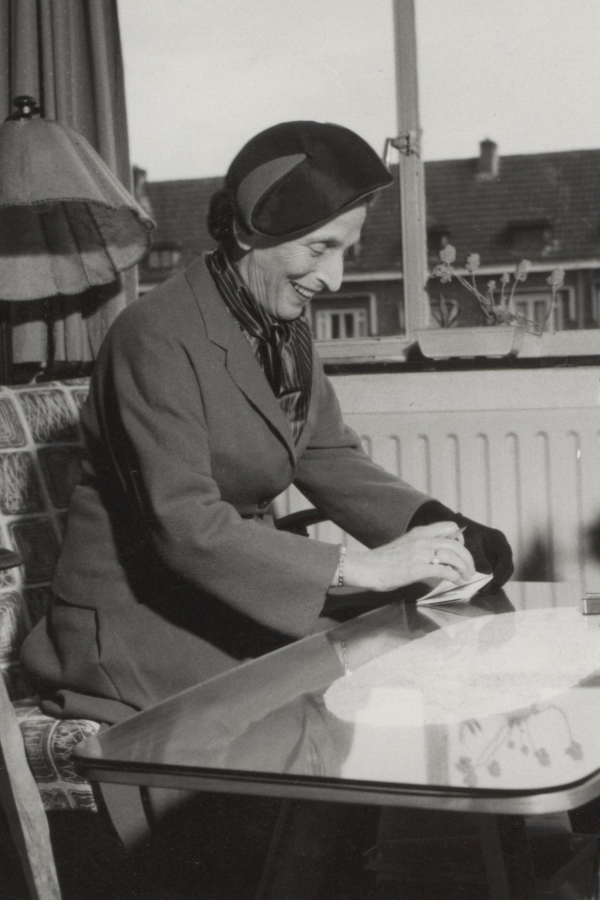 |
| Anefo/Nationaal Archief/Wikimedia Commons |
Our fourth state visit flashback of the week brings us back to Amsterdam in the spring of 1955, where Queen Juliana and Prince Bernhard are preparing to host King Gustaf VI Adolf and Queen Louise of Sweden for a grand state visit!
 |
| Queen Juliana wears Queen Emma’s Sapphires, September 1955 (AFP via Getty Images) |
In April 1955, Queen Juliana of the Netherlands was only days away from celebrating her 46th birthday. She had reigned as Queen of the Netherlands since her mother’s abdication in 1948. Her 17-year marriage to Prince Bernhard was about to face one of its greatest tests: the Greet Hofmans scandal. Hofmans was a faith healer; Juliana had met her while seeking treatments to improve the eye sight of her youngest daughter, eight-year-old Princess Christina (then called Marijke). Prince Bernhard and other courtiers began to believe that Hofmans was unduly influencing Juliana’s politics as well, and in 1956 the royal court split into factions, one aligned with Bernhard (including the heir to the throne, Princess Beatrix), and one aligned with Juliana. Ultimately Bernhard prevailed, expelling Hofmans from her position of influence. Though the Queen and the Prince nearly divorced, they ultimately reconciled and remained married until Juliana’s death.
In Sweden, the world of the royal court was in a much more stable period in the spring of 1955. King Gustaf VI Adolf, the country’s 72-year-old monarch, had reigned quietly and effectively for a little more than four years. Devoted to academic pursuits, and fond of sports, Gustaf Adolf preferred to leave political matters to his ministers, following a pattern of Swedish governance that had been in place for almost half a century. But Gustaf Adolf’s private life had been significantly marked by tragedy. His first wife, Princess Margaret of Connaught, died unexpectedly in 1920; their eldest son (and his heir), Prince Gustaf Adolf, had perished in a plane crash in Denmark in 1947. King Gustaf Adolf was married to his second wife, Queen Louise, who had been Lady Louise Mountbatten before their marriage in 1923. (She was a sister of Lord Mountbatten and an aunt of the Duke of Edinburgh.) The photo above was taken in the royal library in Stockholm in preparation for the Dutch state visit of 1955.
 |
| Anefo/Nationaal Archief/Wikimedia Commons |
The Swedish royal couple arrived at the train station in Amsterdam to begin their state visit on Tuesday, April 26, 1955. The king wore the uniform of a general in the Swedish army, including an eye-catching feathered hat.
 |
| Anefo/Nationaal Archief/Wikimedia Commons |
They were met on the platform by Queen Juliana and Prince Bernhard.
 |
| Anefo/Nationaal Archief/Wikimedia Commons |
King Gustaf Adolf and Queen Juliana took a moment to review Dutch troops stationed on the platform before departing from the station.
 |
| Anefo/Nationaal Archief/Wikimedia Commons |
A grand carriage procession had been organized to convey the royals from the station to the Royal Palace in Dam Square. King Gustaf Adolf and Queen Juliana rode together in the first carriage…
 |
| Anefo/Nationaal Archief/Wikimedia Commons |
…while Queen Louise and Prince Bernhard rode in the second.
 |
| Anefo/Nationaal Archief/Wikimedia Commons |
The procession route through the streets of Amsterdam was lined with cheering crowds. Many homes and businesses along the way flew Dutch and Swedish flags.
 |
| Anefo/Nationaal Archief/Wikimedia Commons |
On arriving at the palace, King Gustaf Adolf and Queen Juliana again took part in a military review.
 |
| Anefo/Nationaal Archief/Wikimedia Commons |
And then both couples made an appearance on the palace balcony, much to the delight of the gathered crowds.
 |
| Anefo/Nationaal Archief/Wikimedia Commons |
The royals posed for a formal portrait inside the palace after their arrival.
 |
| Anefo/Nationaal Archief/Wikimedia Commons |
The images give us a good view of the jewels worn by both Louise and Juliana for this first part of the royal visit. Here, you’ll note that Queen Juliana has paired the briolette drop earrings and the rectangular brooch from her suite of aquamarines with pearls.
 |
| Anefo/Nationaal Archief/Wikimedia Commons |
Queen Louise also wore pearls, including the distinctive diamond and pearl ivy leaf brooch from the Swedish royal vaults. (This is the same brooch recently worn by Crown Princess Victoria in her 10th anniversary portraits.) Dutch press reports noted that her dress was blue, and her accessories were black.
 |
| Anefo/Nationaal Archief/Wikimedia Commons |
Soon after, King Gustaf Adolf left the palace on foot for a visit to the war memorial in Damplantsoen. This was a temporary memorial, built in 1947; it was replaced by the current National Monument in 1956. The king laid a wreath of laurel leaves at the memorial and observed a minute of silence before speaking with military leaders.
 |
| Anefo/Nationaal Archief/Wikimedia Commons |
The afternoon of the first day of the state visit featured a reception on the water. Both of the royal couples were driven to Amsterdam’s docklands, where they boarded a large ship, the Oranje.
 |
| Anefo/Nationaal Archief/Wikimedia Commons |
A reception was held on board in honor of the visiting king and queen. During the reception, King Gustaf Adolf and Queen Louise were presented with diamond-encrusted anchor badges, a gift from Amsterdam’s harbor community. The badges were given in gratitude for the Swedish efforts to feed the occupied Dutch people during the famine of 1944-45.
 |
| Anefo/Nationaal Archief/Wikimedia Commons |
King Gustaf Adolf also received another very appropriate gift during the reception. The king was a keen amateur archaeologist, with a special interest in the cultures of ancient Italy. According to Leidsch Dagblad, the king was surprised and delighted when the chairman of the Amsterdam Chamber of Commerce presented him with “an ancient Greek coin from Carthage from 410-360 BC, with the head of Persephone, and two Dutch medals from 1655, depicting the former town hall on Dam Square, now the Royal Palace.”
 |
| Anefo/Nationaal Archief/Wikimedia Commons |
The royals returned to the Royal Palace for a glittering state banquet following the reception.
 |
| Anefo/Nationaal Archief/Wikimedia Commons |
Both queens wore impressive jewels for the occasion. Queen Louise donned Queen Sofia’s Tiara with additional diamond jewels, including the Karl Johan Earrings.
 |
| Anefo/Nationaal Archief/Wikimedia Commons |
Queen Juliana sparkled in the sapphire parure that she inherited from her grandmother, Queen Emma. Here, she wears Emma’s tiara, necklace, bow brooch, and bracelets, plus a pair of diamond drop earrings.
 |
| Anefo/Nationaal Archief/Wikimedia Commons |
After dinner at the palace, the royals went to the opera, where — after standing through both the Dutch and Swedish national anthems — they saw a performance of Mozart’s The Magic Flute.
 |
| Anefo/Nationaal Archief/Wikimedia Commons |
The second day of the state visit (Wednesday, April 27, 1955) began with a special reception in the throne room at the Royal Palace in Amsterdam. King Gustaf Adolf and Queen Louise received representatives of the Dutch National Bakers Committee.
 |
| Anefo/Nationaal Archief/Wikimedia Commons |
The Dutch bakers presented the royals with a special crystal art piece in gratitude for the flour that Sweden sent to the Netherlands during the war. “Swedish bread,” as the Dutch called it, had helped to alleviate the famine that had taken hold before the Allies liberated the country from German occupation in 1945.
 |
| Anefo/Nationaal Archief/Wikimedia Commons |
The rest of day two was packed with engagements; Leidsch Dagblad even commented that the schedule demanded “an awful lot from the vitality of the royal guests.” The royals traveled to Lisse, one of the centers of the Dutch flower-growing region, in the western part of the country.
 |
| Anefo/Nationaal Archief/Wikimedia Commons |
There, they toured the Keukenhof, one of the world’s largest botanical gardens, famous for its tulip season in the spring.
 |
| Anefo/Nationaal Archief/Wikimedia Commons |
They also made a stop at the Waterloopkundig Laboratorium, a scientific institute devoted to hydraulics in Delft.
 |
| Anefo/Nationaal Archief/Wikimedia Commons |
They also carried out engagements in The Hague, including a visit to the old City Hall.
 |
| Anefo/Nationaal Archief/Wikimedia Commons |
In the evening, the royals returned to Amsterdam for a special gala dinner. The event was held in the Rijksmuseum, the Dutch national museum of arts and history.
 |
| Anefo/Nationaal Archief/Wikimedia Commons |
For the dinner, Queen Juliana dazzled in diamonds, including the Dutch Diamond Bandeau and the Dutch Diamond Festoon Necklace.
 |
| Anefo/Nationaal Archief/Wikimedia Commons |
Queen Louise wore one of the most splendid suites from the Swedish royal collection: the Leuchtenberg Sapphires.
 |
| Anefo/Nationaal Archief/Wikimedia Commons |
As the third and final day of the state visit (Thursday, April 28, 1955) began, King Gustaf Adolf traveled with Queen Juliana and Prince Bernhard to Rotterdam, where they undertook a slate of activities. One of these was a visit to a special exhibition of English landscape paintings from the eighteenth and nineteenth centuries, including works by Constable, Gainsborough, and Turner.
 |
| Anefo/Nationaal Archief/Wikimedia Commons |
Queen Louise stayed back in Amsterdam, where she toured various housing complexes in the city, including an apartment building designed especially for single women.
 |
| Anefo/Nationaal Archief/Wikimedia Commons |
Louise wore a very impressive diamond brooch for these housing visits: you can just see the Swedish Diamond Lozenge Brooch peeking out from beneath her lapel.
The visit concluded following one more dinner, which was held without cameras at the Swedish legation. Afterward, King Gustaf Adolf and Queen Louise headed home to Stockholm, where they rested up before making another international trip: a two-week private visit to Louise’s home country of Britain in May.
Leave a Reply